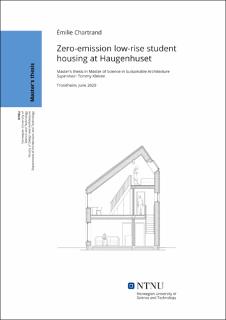| dc.contributor.advisor | Kleiven, Tommy | |
| dc.contributor.author | Chartrand, Émilie | |
| dc.date.accessioned | 2020-07-24T16:01:48Z | |
| dc.date.available | 2020-07-24T16:01:48Z | |
| dc.date.issued | 2020 | |
| dc.identifier.uri | https://hdl.handle.net/11250/2670205 | |
| dc.description.abstract | Som svar på behovet for studentboliger i Trondheim forventes Sit å utvide bygningsmassen ytterligere. Som en av hovedutviklerne for studentboliger i området, har Sit muligheten og ansvaret til å bidra til å senke utslippene fra sine eksisterende og nye bygninger ved å implementere lavutslippsstrategier. Potensialet for å redusere klimaavtrykket til studentboliger er demonstrert i denne avhandlingen gjennom utformingen av fem småhus på Haugenhuset, på Moholt Studentby. Bygningene ble designet ut fra prinsippene for bygging med nullutslipp og integrert energidesign. Designet ble gjort på tre nivåer, fra bygning, nabolag, til landskap.
Energi- og miljøanalysene ble utført fra den innledende fasen av designen, og influerte form og utforming. Taket spiller en stor rolle i designkonseptet, ettersom det ble formet for å optimalisere elektrisitetsproduksjonen på stedet, samtidig som det gir plass til en mezzanin. Den enkle og kompakte formen rommer mellom fem og åtte studenter. Bruken av passiv strategi gjenspeiles i bygningenes orientering og konfigurasjon. Konfigurasjonen er inspirert fra de nærliggende murbygningene. Et felles uterom mellom bygningene har et drivhus laget av gjenbrukte murstein og vinduer fra den eksisterende bygningen på stedet.
Bygningene produserer fornybar strøm nok til å balansere utslippene fra drift. Derfor viser denne avhandlingen potensialet i å integrere slike strategier i utformingen av studentboliger. | |
| dc.description.abstract | In response to the need for student housing in Trondheim, Sit is expected to further expand its building stock. As being one of the main developers for student housing in the area, Sit has the opportunity and responsibility to contribute to lowering the emissions from its existing and new buildings by implementing low-carbon strategies. The potential of reducing the climate footprint of student housing is demonstrated in this thesis through the design of a set of five low-rise buildings at Haugenhuset, in Moholt Studentby. The buildings were designed based on the principles of zero-emission building and integrated energy design. The design was done on three levels, from the building, the neighbourhood, to the landscape.
The energy and environmental analyses were conducted from the preliminary stage of the design, informing the shape and layout. The roof plays a big role in the design concept, as it was shaped to optimize the on-site electricity generation, while providing space for a mezzanine. The simple and compact shape houses between five and eight students. The use of passive strategies are reflected in the orientation and configuration of the buildings. The configuration is inspired from the neighbouring brick buildings. A common outdoor space at the center of the site features a greenhouse made from reused bricks and windows from the existing building on-site.
The buildings generate enough renewable electricity to offset the emissions from operation. Consequently, this thesis showcases the potential of integrating such strategies in the design of low-rise student housing. | |
| dc.publisher | NTNU | |
| dc.title | Zero-emission low-rise student housing at Haugenhuset | |
| dc.type | Master thesis | |
